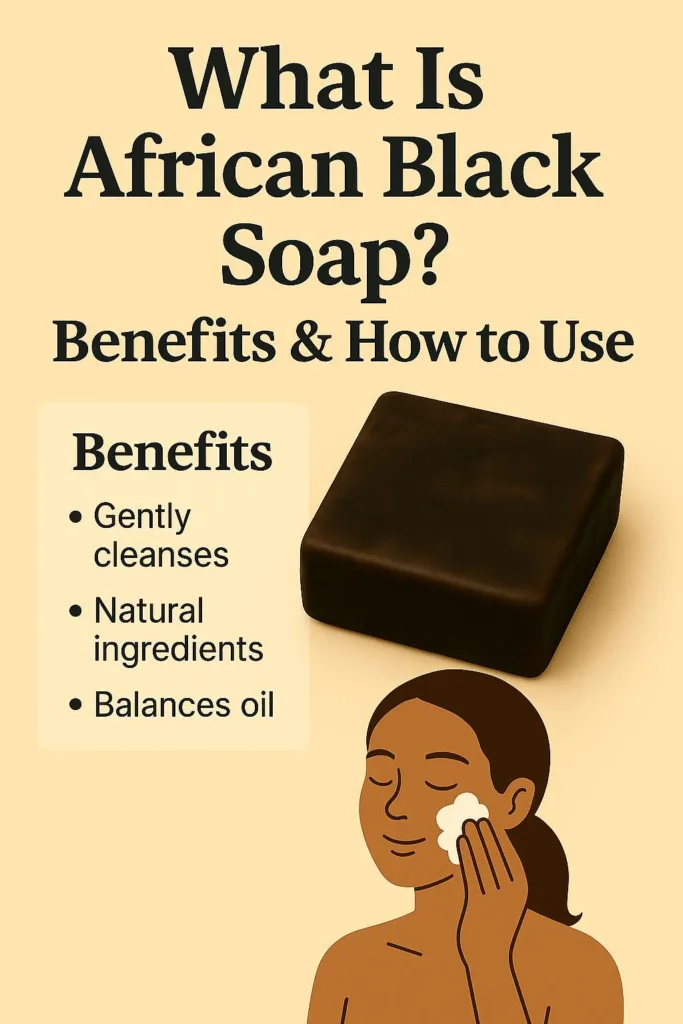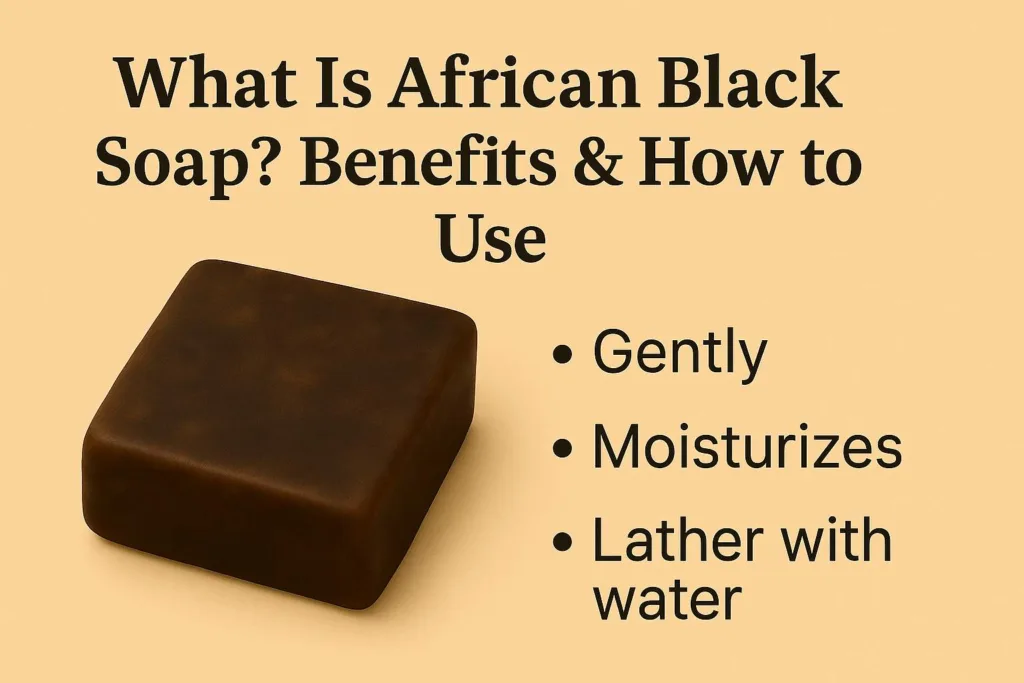You’ve probably seen it—that dark, mottled bar sitting on a shelf, looking nothing like the smooth, uniform soaps you’re used to. What is African black soap, and why does it look so different? African black soap is a traditional West African cleanser that’s been used for centuries, offering gentle exfoliation and thorough cleansing without synthetic additives. Whether you’re dealing with oily skin, body breakouts, or just want to try something more natural, this guide covers everything you need to know about using African black soap effectively. I first picked up a crumbly bar at a local market because I was curious about its reputation for helping with stubborn body acne—and quickly learned there’s more to this humble soap than meets the eye.

Quick Answer
What is African black soap? African black soap is a traditional West African soap made by combining plant ash (often from plantain skins or cocoa pods) with oils like shea butter and palm kernel. It’s naturally alkaline, gently exfoliating, and prized for cleansing face and body without heavy additives.
Origins & Traditional Making
African black soap originates from West African communities, particularly in Ghana, Nigeria, and surrounding regions. The traditional process involves burning plantain skins, cocoa pods, or palm kernel shells to create ash, which is then mixed with water to form lye. This lye is combined with oils like shea butter, palm kernel oil, and coconut oil, then cooked and stirred for hours before being left to cure for weeks.
When I first held a bar, it felt surprisingly soft and had an earthy, almost smoky scent—completely different from commercial soaps. The texture was uneven and crumbly, which initially made me wonder if it was defective. I later learned this irregular appearance is actually a sign of authentic, handmade soap. Different regions have their own variations: some communities add honey, aloe vera, or local herbs, creating subtle differences in color, texture, and properties.
Core Ingredients & The Chemistry
The foundation of African black soap lies in its simple yet effective ingredient list. Common oils include shea butter (moisturizing), palm kernel oil (cleansing), coconut oil (lathering), and sometimes palm oil. The plant ash provides the alkaline component that creates the soap through saponification.
This ash gives African black soap a naturally high pH, typically ranging from 9-11, making it more alkaline than your average facial cleanser. This explains why some people experience that “squeaky clean” feeling—the alkaline nature effectively removes oils and debris but can be drying if overused. If you have combination skin like mine, aim for 30-60 seconds of contact time rather than extended lathering to avoid over-cleansing.
Benefits People Actually Notice
Users consistently report that African black soap provides thorough cleansing without leaving a heavy residue. The mild exfoliating properties come from the texture and alkaline nature, helping to remove dead skin cells and unclog pores. Many people find it particularly helpful for areas prone to ingrown hairs, like legs after shaving or the back where body breakouts occur.
After using it consistently for about a week, I noticed my skin felt less congested, particularly on my back where I’d been dealing with occasional breakouts. The soap seemed to cut through the buildup of body oils and lotion residue that other cleansers left behind. However, it’s important to set realistic expectations—this isn’t a miracle cure, but rather a thorough, no-nonsense cleanser that does exactly what soap should do.

Who Should (and Shouldn’t) Use It
African black soap works well for normal to oily skin types and those dealing with mild congestion or body breakouts. People with very dry, sensitive, or compromised skin should approach with caution, as the alkaline nature can be irritating. Eczema-prone skin may react poorly to the high pH.
I learned this the hard way when I got enthusiastic and used it twice daily on my face for a week—my skin felt tight and looked slightly irritated. Scaling back to every other day made all the difference. Always patch test on a small area first, especially if you have reactive skin. Start with once or twice weekly use and adjust based on how your skin responds.
How to Use It: Face, Body, Hair
Face routine: Wet the bar and rub between your palms to create a lather—avoid rubbing directly on facial skin. Apply the foam gently, leave for 30-60 seconds maximum, then rinse thoroughly. Use 2-3 times per week initially.
Body routine: You can be less cautious here. Lather the soap directly on wet skin or in your hands, then apply all over. The soap cuts through body oils effectively, making it great for post-workout cleansing.
Hair clarifying: Use occasionally as a clarifying treatment to remove product buildup. Work the lather through wet hair, focusing on the scalp, then follow with a good conditioner since it can be drying.
I prefer using it in the evening with lukewarm water, followed by a ceramide-rich moisturizer. This routine helps prevent any potential dryness while maximizing the cleansing benefits.
Side Effects & Fixes
Common issues include temporary tightness, dryness, or mild stinging on broken skin. These effects usually indicate you’re using it too frequently or leaving it on too long. Simple fixes include reducing frequency, shortening contact time, or alternating with a gentler cleanser.
I once made the mistake of using it immediately after exfoliating—the combination was too much for my skin and resulted in noticeable irritation. Now I avoid using it on the same day as other exfoliating treatments and always follow up with moisturizer.
Authentic vs. Imitations
Real African black soap has a mottled, uneven appearance with colors ranging from light brown to deep chocolate—rarely jet black. It should feel soft and slightly crumbly, with an earthy, smoky scent. Be wary of perfectly smooth, uniformly black bars with strong fragrances, as these are likely synthetic imitations.
When shopping, I look for minimal ingredient lists featuring recognizable plant oils and avoid bars with artificial colors, sulfates, or lengthy chemical names.
Storage & Care
African black soap melts quickly when left wet, so proper storage extends its life significantly. Cut the bar into smaller pieces, use only one piece at a time, and store the rest in a cool, dry place. Use a soap dish with drainage holes and let each piece dry completely between uses.
I keep my main bar wrapped in a cool cabinet and cut off small pieces as needed—this prevents the entire bar from turning into mush in my humid bathroom.
Comparisons
African black soap vs. charcoal soap: Black soap gets its color from plant ash, while charcoal soap contains activated charcoal. Black soap is typically more alkaline and has a softer texture.
vs. Castile soap: Castile soap is made from olive oil and has a lower pH, making it gentler but potentially less effective at cutting through heavy oils and buildup.
Choose African black soap if you want thorough cleansing and don’t mind a higher pH. Choose Castile if you prefer something milder for daily use.
Personal First-Use Experience
My first bar was darker than expected, with an almost chocolate-like color and visible specks throughout. When wet, it created a surprisingly rich, creamy lather that felt different from commercial soaps—less slippery, more substantial. The immediate after-feel was very clean, almost too clean, which taught me to moisturize right away. One small downside: the bar lasted only about three weeks with daily use, much shorter than regular soap bars.

FAQs
Is African black soap good for acne? It may help with mild acne by thoroughly cleansing pores, but it’s not a targeted acne treatment.
Can I use it every day on my face? Start with 2-3 times per week; daily use may be too drying for most people.
What is the typical pH? Usually between 9-11, making it quite alkaline.
Is it okay for eczema-prone skin? Generally not recommended due to the high pH, which can worsen eczema.
Why does my bar look uneven? This indicates authentic, handmade soap—perfectly smooth bars are likely machine-made imitations.
Can I use it as shampoo? Yes, occasionally as a clarifying treatment, but always follow with conditioner.
How long should I leave the lather on? 30-60 seconds maximum for face, longer for body if tolerated.
African black soap offers a return to simple, effective cleansing. While it requires some adjustment in technique and frequency, many users find it a worthwhile addition to their skincare routine once they learn to use it properly.